We study the elephant (part 2)
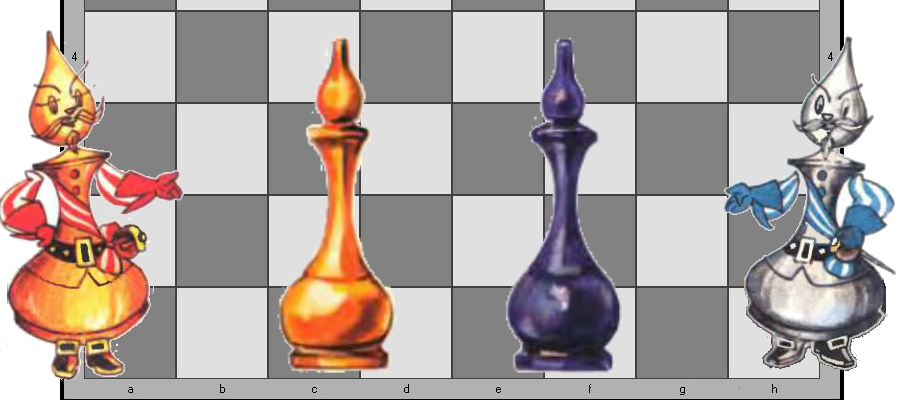
We continue the study of chess pieces. The next figure is the elephant.
It would seem that an elephant is a figure that walks even easier than a rook. But, nevertheless, during the initial study of the bishop there are more problems associated with it than with the rook. Children more easily perceive movement along horizontals and verticals than along diagonals. To teach a child to walk an elephant - go under the cat. There are waiting for you charts, some are not the most simple (for children).
You can read the previous parts of the course here:
')
0. A dozen tips - how to teach a child to chess. And not only
1. We study the rook (Part 1)
Before you begin to study an elephant, you should talk about what it is, give the following concepts:
1. How the elephant walks.
2. What are the elephants (black-and white-field).
3. The names of the elephants remaining in the endings (single-color and multi-colored).
After we have learned the rook, our goals expand a little. Now we must not only learn how to walk an elephant, but also understand who is stronger than an elephant or a rook. Therefore, before we start studying an elephant, we ask the child to put the elephant first, and then the rook in the center of the field and count the number of fields that these pieces can go (the elephant has 13 fields, the rook has 14). Then we put the bishop and the rook in the corner - again we count the number of fields that the pieces can go on (elephant - 7 fields, rook - 14). We explain to the child that the strength of the figure is determined by how many fields it can go.
It is necessary to convey to the child that if the figure has less moves, then it is weaker than the one with more moves. This aspect must be done further with all the figures. And then it will be very easy to explain the power of the figures and their value based on this power.
Understanding the cause-and-effect relationship between the power of the bishop and the rook, we begin to build in the child's brain the understanding that everything in the world is interconnected.
In addition, studying the power of the figures, it is necessary to convey to the child methods of dealing with each specific figure. This we will gradually pass in the tasks.
Those who studied chess in childhood using other methods know perfectly well how to deal with each particular figure. In sports training, for example when studying elephant endings, the strengths and weaknesses of an elephant are considered. But all this later. What I like in the method of I.G. Sukhin - the fact that the strength and weakness of the figures are studied, as it were, between other things, in exercises and tasks. In this case, the child in practice learns methods of dealing with figures.
We proceed directly to the study of the elephant. The types of tasks are about the same, but you will soon see differences in comparison with the rook, I will stop there. The first types of exercises are similar to the tasks with the rook. To those tasks that are as clear as to perform - I will not give comments. A general comment on such tasks is simple - watch the actions of the child, he will sometimes be mistaken for various reasons. The reasons are individual (again, I do not consider the geeks, the program is general education).
Exercise number 1 . "No man is an island".


Exercise number 2 . "Shortest way"

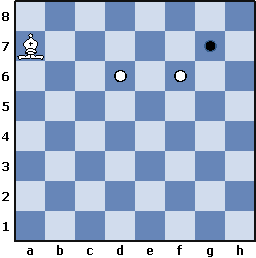

In the first task, the shortest path is 2 moves, in the second and third - 3 moves.
Exercise number 3 . "Labyrinth"
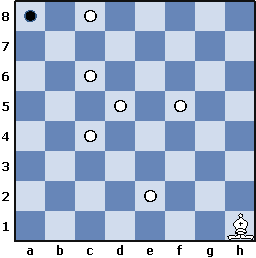


By this exercise should make a small remark. The fact is that children in task number 1 usually pass it in 9 moves, making a loop through the bottom. The optimal passage mode is 7 turns. Almost everyone flies into a corner, so I usually brake them and say that I have to go in 7 moves. With the remaining tasks, problems most often do not arise.
Exercise number 4 . "Outsmart the sentries"

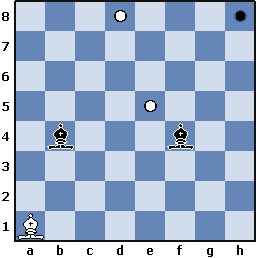
Exercise number 5 . "Capture control field"


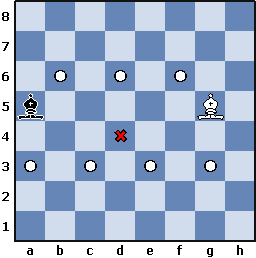
Task number 1 is performed easily.
Task number 2 requires the child to understand that sometimes you have to wait until the figure leaves, because she walks too. But precisely in this task it is necessary to pay attention to the fact that the opponent's bishop must not be allowed onto a long diagonal - = he is not being chased away from there. And the power of the elephant is in this.
In task number 3, everything is trickier - it is solved much less frequently, because it requires a waiting move with its elephant, otherwise the black elephant takes the control field under protection and does not leave it. For the decision it is necessary to make a move back and then rush to the control field.
Exercise number 6 . "Restricted mobility."



Before you give the child to solve these tasks - decide them yourself, but you can also pierce. Again, we count the pace (the number of moves for how much the bishop reaches the goal). And in the last task we make a waiting move when we reach the end of the board - we don’t climb into the corner, the elephant is caught there.
Now we come to the most interesting in the study of the elephant. The fact is that now a rook is introduced into the tasks, which the child learned earlier. Using the example of the following tasks, the student needs to understand who is stronger - the rook or the bishop. How the rook can fight with the bishop, and how the bishop can fight with the rook.
Exercise number 7 . "Attack of the enemy figure."


The meaning of the task is very simple - you just have to attack the black piece in the first move . And in all possible ways. The child himself must determine that the bishop attacks only one way on the boat, and the boat - almost always two. The children try to kill the figure, but the purpose of the task is different - to attack. And it is necessary to inform and explain to the child.
Remark number 1 . You can make a task where the bishop attacks in two ways on the rook, but in reality it is rather an exception than a rule, because the elephant is weaker. And the goal of these tasks is to convey to the child that the elephant is weaker . The child must make this conclusion and fix it.
Exercise number 8 . "Double punch".

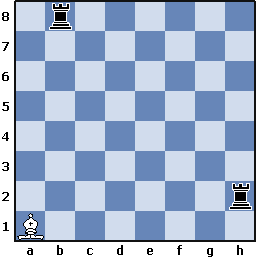
In this task, the child must attack two black pieces at the same time with the first move. Actually both the rook and the bishop can do it - in this they are similar. And, again, it is not necessary to beat the black pieces.
Exercise number 9 . "Take".

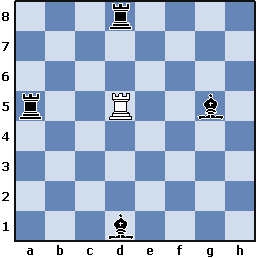

In this task, everything is clear - you need to beat an unprotected figure. It is interesting that children do not always see which figure is unprotected. In addition, protection can pass through the white figure. Difficulties in children sometimes arise, but not so often. Although control is necessary, carefully watch what figure the children will beat.
The child must understand that it is possible to protect the figure “through the opponent’s head”, i.e. and attacking and defending your figure at the same time. Of course, children do not see such defenses for a long time and do not know how to apply, but this should be emphasized - so that they know about this method. Further, in tasks, such methods of protection will be applied.
Exercise number 10 . "Protection"

It is necessary to make such a move that it would be unprofitable for Black to take a white piece. Since the cost of the figures has not yet been passed, then the one who has lost all the figures loses. And about this moment it is necessary to remind the child before completing the task.
Exercise number 11 . "Win a piece"

It is necessary to make such a move that in case of any answer of Black, in the second move pick one of the black pieces. Remember to remind you that the black pieces in this task are walking.
Exercise number 12 . "Outsmart the sentries." Again we return to the sentries, but now the sentries will also have rooks.



On this exercise, I will focus in more detail.
Task number 1 . Here difficulties usually do not arise, although the children strive to jump at the beginning on the field f3.
Task number 2 . This task is usually liked by girls. The fact is that if you draw a trajectory like an elephant goes - it turns out a heart. Girls - delighted.
Task number 3 . The most cerebral task. In it, children must break themselves in order to solve it. Few of the children can solve it right away, and usually these are children older than 8 years old. Anyone who is younger is stuck on a simple focus - on the second move, the elephant must step back, return a little bit in order to reach the goal later. I suspect that the move back diagonally, in children, is associated with going back altogether, they perceive the new trajectory as the opposite - and in fact this is not so.
Try not to interfere with the solution of this problem only if the child starts to get mad at all. And another point - the fact is that this problem is solved by an ordinary brute force. An elephant usually has two moves from each field - one backward and one second forward. There is another option to a dead end - but they are immediately rejected. But it is on this task that the children sit for 20 minutes. And even more. Although after they decide it - they have a mad joy that they solved it.
This task is actually rather difficult for some reason for beginner children. So - take it seriously.
Exercise number 13 . "Take off the time."



This is a new kind of tasks. The fact is that in the boat itself, we could not beat the sentries - as soon as they attacked the boat, it immediately killed us. Now the figures are different, and we can do it. The meaning of the tasks is to beat the black pieces. Black pieces do not walk, but shoot like snipers (see the task “Outwit the Sentinels”).
In this task, the child is already starting to compare the figures of the rook and the bishop. In his head comes the distinction between the type of moves and the figures themselves. But with their power is not so clear.
Exercise number 14 . "Capture the control field." Now with different figures.



Here, children already expect some difficulties. The fact is that in these tasks it is necessary not only to capture the control field, but also to force the opponent to go where you need to go. And for this you need to attack the field itself is the goal. Consider more.
Task number 1 . It's all quite simple. In order to get to the control field, we need to attack him, but so that the rook does not protect him. This can be done on field c6. Although children try to walk on c2 sometimes, but in this case, the rook immediately defends with a move to a8, and the bishop will not be able to drive it from the vertical.
Task number 2 . Here the rook forces the bishop to walk on the a7-square, attacking the control field from the b2-square. The fact is that an elephant can protect the b8 field by going either to a7 or to h2. So, the h2-b8 diagonal is long, and it is impossible to drive the bishop out of the rook from there. Therefore, first b2, then the elephant goes to a7, we make a waiting move vertically to any field (but not for battle) - the elephant leaves and we capture the field b8.
Task number 3 . It looks like the second. It is necessary to determine the long diagonal - this is the a3-f8 diagonal. And do not let an elephant go there forcing him to walk on the field c1. Then it is necessary to drive the elephant from the a3-c1 diagonal and capture the control field. Those. rook sequence - d3 - b3 - a3.
Exercise number 15 . "Restricted mobility."


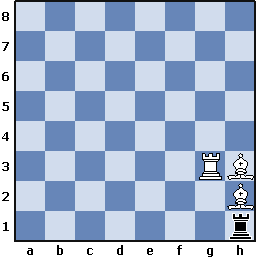
Task number 1 is quite simple. The elephant is caught immediately.
Task number 2 - there are already some difficulties. As in exercise No. 12, you can not let an elephant on a long diagonal. Those. simple solution - c1 - c7
Task number 3 . Here we should dwell on the fact that we need to beat all the figures of the enemy. In this case, we win if we have at least something. Those. it is necessary to block the black rook with an elephant. The right decision is to go to the g1 field as an elephant.
Exercise number 16 . "The game of destruction."


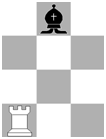
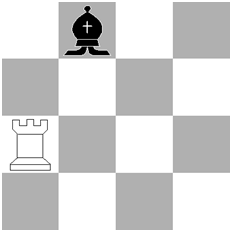
In these tasks comes the final understanding of how and when you can fight with the bishop or the rook. I will give some tasks from the course of I.G. Sukhin.
Task number 1 is solved quite simply - in one move. The elephant is killed by the second move.
Task number 2 is solved in two moves - the bishop is killed by the third move.
Task number 3 . If here the bishop gets out onto the black diagonal of three cells - then the rook will not catch him. Therefore, the main task is not to let him get out there. The solution is simple - to the right for 2 cells, then left for one. And the elephant beats in the third move.
Task number 4 . The solution is simple to horror, but children usually can not find it. Here the trick is that you can not let an elephant on a long diagonal. There are 4 squares, the bishop's rook catches hard on 3 cells, and on 4x it will never be able to catch him. Therefore, the whole task is the resistance to hitting an elephant on a large diagonal. Children usually sit on this task for 15-20 minutes. And then I tell them.
The optimal hint is to say that the elephant on the diagonal is stronger and you cannot catch it there. And ask the child to start blocking the exit of the bishop on the diagonal every turn. Already in the second move, a child comes amazed, and at 4m (when he beats an elephant) - joy. In general, it is interesting to observe these processes and this is exactly the task - all the stages are obvious - difficulty, surprise, amazement, joy.
Well, now we’ve finished walking the elephant. It would seem - a slight figure, but not so simple. After completing these tasks, the child must know how the elephant walks, to understand what his strength is. And how the bishop can resist the rook. And also, he must understand that the rook is stronger than the bishop and why. In addition, having an bishop instead of a rook does not mean losing. Playing chess, you must have come across this more than once. For a successful game in the head there should not be any restrictions and underestimations of the elephant. An elephant is also a figure, yes - not the strongest, but a figure. And she can resist. But this must be able to do. The power of the elephant is in the diagonals. Having taken a long diagonal of the elephant on it and begins to work, there it is strong. The rook cannot cope with the bishop on the long diagonal. It is this knowledge, besides how the elephant walks, the child must understand in the end.
I will write in pursuit again - the child should do everything himself. The task of general education chess is to inculcate interest in the subject. Children are interested in solving puzzles, especially when they know what they can handle. There are a lot of joy in solving the above tasks, especially if the tasks are complex at first glance. I deliberately give simple tasks and are a bit more complicated and more interesting; you will be more than breaking a head with your son or daughter. Yes, girls like to solve such puzzles. If it is not from under the stick.
In general, good luck. And I will go to prepare the following parts of the study of chess rules. After the bishop we have the queen. Well, the task more difficult naturally.
For those who have recently joined the course, I remind you that all the tasks in this article are given in the textbook “Sukhin I.G. Chess, first year, or There cells are black and white wonders and secrets are full: A textbook for primary school, the first year of study. In 2 parts. - Obninsk: Spiritual Revival, 2017 ”.
And yet, in the last article I did not express my gratitude to the authors of the Kvetka program - I express it now. All charts scored for articles are made in this program. Convenience for me personally - undeniable. I simply redrawn the set of pieces and replaced the pawns with checkers, and the king with a cross. As a result, the development of diagrams takes the minimum amount.
Source: https://habr.com/ru/post/411063/
All Articles